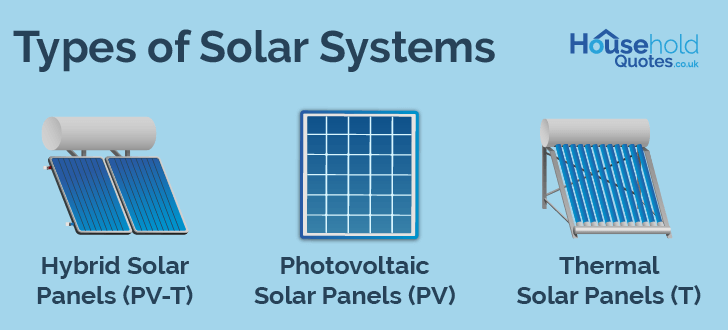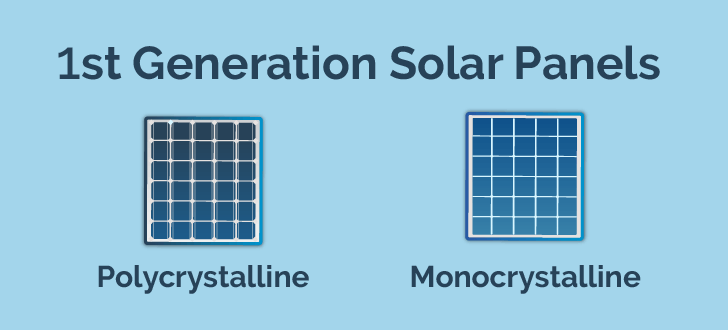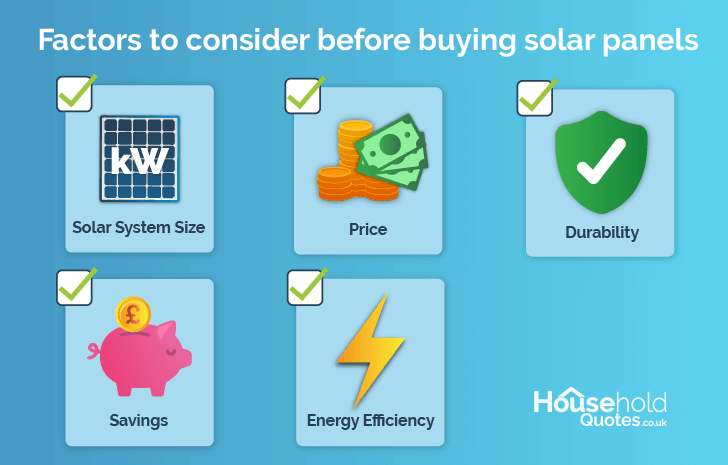Answer these simple questions and we will find you the BEST prices
Which type of solar quotes do you need?
It only takes 30 seconds
100% free with no obligation

Get up to 4 quotes by filling in only 1 quick form

Compare quotes and find yourself the best deal

Increase the value of your home by installing solar panels
- Householdquotes.co.uk
- Solar Panels
- Solar Panel Types
Different Types of Solar Panels in the UK Explained (2025)


- Monocrystalline is the most efficient solar panel for residential use with an efficiency rate of 18% - 22%. CPV is the most efficient commercial solar panel with an efficiency rate of 35% - 50%.
- Quantum dot solar cells are the newest innovation, currently in the research stage, that can potentially achieve a conversion rate efficiency of 66%.
- Thin film solar panels are the cheapest option, they cost around £400 and £800 per kW.
There are different types of solar panels in the UK with varied features as well as pros and cons. Therefore, it is important to know everything about the type of solar panels you want to install on your house to compare and choose the best option worth your investment.
We will walk you through the different generations of solar panels and discuss the prices, durability, savings and energy efficiency of the solar panels. After reading through all the relevant factors you can decide if solar panels are worth it in the UK for your home.
Want to know more about different solar panels and their costs but do not have the time to browse through countless websites with unverified sources? We have the solution for you. Get in touch with our trusted team of solar experts by simply filling out the 30-second form and get up to 4 free, non-binding quotes on different solar panels suited to your specific needs instantly!
The different types of solar panels in the UK

There are three different types of solar systems in the UK that have different energy efficiencies. Photovoltaic solar panels (PV) convert solar radiation directly into electrical energy with the photovoltaic effect. Thermal solar panels (T) absorb solar radiation and convert it into heat energy which can then be used for water or space heating. Hybrid solar panels (PV-T) combine the features of these two types of solar panels and generate both heat and electricity. There are both residential and commerical solar panels available.
Photovoltaic solar panels are further categorised into multiple generations based on the technology and material used to generate electricity.
1st generation solar panels

These solar panels function on silicon wafer-based technology (c-Si). Monocrystalline and polycrystalline solar panels, the traditional and most popular type of solar panels in UK households, fall into this category. These are also the best solar panels for residential properties.
| Solar panel type | Cost (4kW) | Degradation rate (per year) | Efficiency |
|---|---|---|---|
| Monocrystalline | £6,400 - £8,000 | 0.3% - 0.8% | 18% - 22% |
| Polycrystalline | £4,800 - £6,400 | 0.8% - 1% | 15% |
The two types of silicon solar panels are explained in more detail:
-
Monocrystalline: It is made from a single, pure, silicon crystal cut into wafers and is easily identifiable by its black colour. It is one of the most efficient solar panels with an efficiency rate of 18% - 22% and is suitable for maximising energy yield from a small roof or limited space.
It is also the most expensive residential solar panel with a 4kW system costing anywhere between £6,400 - £8,000. The cost ranges from £1.60 to £2 per watt for these solar panels and these panels last about 25-30 years.
-
Polycrystalline: This is a more economical version of crystalline-based solar panels, with a slightly lower efficiency of around 15%. It can set you back by £4,800 - £6,400 for a 4kW system, with the price per watt ranging from £1.20 to £1.60.
These panels are ideal if you are looking for a cheaper option and have no problem devoting more roof area. The lesser efficiency means that you would need more panels and more space, to achieve the desired energy output. They will last you for 23-25 years.
2nd generation solar panels
Thin film solar panels are categorised as 2nd generation solar panels and are the cheapest solar panels available in the UK. These panels are made by placing thin layers of photovoltaic material onto a substrate such as metal, plastic or glass.
If you are looking for an affordable, lightweight option that can be easily installed, thin film solar panels might be the answer.
| Solar panel type | Pros | Cons |
|---|---|---|
| Amorphous silicon (a-Si) | Lower manufacturing costs compared to crystalline silicon | Low efficiency (6%-8%), faster degradation |
| Cadmium telluride (CdTe) | Low manufacturing costs, flexible, long-lasting | Not available for residential installation, toxic materials used |
| Copper indium gallium diselenide (CIGS) | High efficiency (18%-23%) | Complex manufacturing process |
| Organic photovoltaic cells (OPV) | Low manufacturing costs, environmentally friendly materials used | Short life span (5-20 years) |
| Dye-sensitised solar cells (DSSC) | Low manufacturing costs, flexibility | Low efficiency (11%-14%), stability issues |
Thin film solar panels are distinguished based on the specific photovoltaic material used such as amorphous silicon (a-Si), cadmium telluride (CdTe), copper indium gallium diselenide (CIGS), organic photovoltaic cells (OPV) and usually cost around £400 and £800 per kW and £1.04 per watt.
- Amorphous silicon (a-Si): These solar panels have an efficiency rate of 6% - 8% and a lifespan of 10-20 years, the shortest amongst thin film solar panels. The annual degradation rate is 0.3% - 2%. It is also much cheaper than crystalline silicon solar panels and is predominantly used in building integrated PVs.
- Cadmium telluride (CdTe): One of the cheapest options for solar cells, these panels have an efficiency of 9% - 12%. They last for 25 years and have a degradation rate of 0.2% - 0.5%. They are available in both flexible and rigid formats. These cells have the shortest energy payback time and are the least carbon-intensive in production. They are mainly used for commercial/industrial applications.
Organic photovoltaic cells (OPV): With an efficiency of around 11%, OPV solar cells are much cheaper than other thin film solar cells. They also have a shorter lifespan of 5-20 years because of the use of organic materials which degrade faster over time.
OPV also offers an aesthetic advantage as it comes in various colours and can also be transparent, making it a suitable choice for building integrated PV installations.
Copper indium gallium diselenide (CIGS): This thin film solar cell technology is extremely energy efficient at 18% - 23% but is comparatively more expensive as it performs better in extreme temperatures.
These cells are also more versatile as they can be used for solar roof tiles, building integrated PV and flexible PV modules. They last almost 25 years and have a degradation rate of 0.2% - 0.5%. They are primarily used for commercial or industrial applications.
Dye-sensitised solar cells (DSSC): These solar cells possess an efficiency rate of 11% - 14% and have a relatively low manufacturing cost. Their durability is 25 years and they are typically used for BIPVS and small electronic devices.
Other types of thin film solar cells in the development stage are perovskite solar cells and Copper zinc tin sulphide (CZTS) with promising potential for energy efficiency and affordability.
3rd generation solar panels
The third generation of solar cell technologies is highly efficient and is capable of surpassing the Shockley–Queisser's efficiency limit of 33%. There are multiple types of technologies under development with different materials that could advance the solar panel industry significantly in the future.
It refers to the maximum theoretical efficiency of a photovoltaic (PV) cell. It is calculated by examining the amount of electrical energy that is extracted per incident photon.
-
III-V multijunction cells: These solar cells are extremely efficient at 30% - 45% and are mainly used for industrial applications. The cells are made out of compound semiconductors with elements from groups III and V of the periodic table.
Concentrator Photovoltaics (CPV): This technology uses lenses or curved mirrors to generate energy and is highly efficient at 30% to 40% under ideal weather conditions. The energy output is significantly affected by diffuse radiation when the weather is cloudy.
Quantum dot solar cells (QDSC): This is an emerging technology that employs quantum dots as the radiation absorbent. Theoretically, this technology can reach an efficiency of more than 60% under ideal conditions, but the demonstrated efficiency rate is around 18%.
This technology is poised to be a highly efficient and low-cost alternative to conventional solar technologies in the near future.
Up conversion and down conversion: Both of these approaches aim to reduce spectral mismatch losses and improve cell efficiency by utilising the solar spectrum. The research is still in the nascent stages.
Intermediate band gap solar cells: These solar cells possess a theoretical efficiency limit of 63%, studies are underway to test the practical applications of the technology with different semiconductor materials such as quantum dots.
The future of solar panels
Several promising solar cell technologies are being continuously researched to reach new levels of energy efficiency at minimal production costs. Researchers are experimenting with different materials and approaches to cater to a wide variety of solar energy needs.
Smart technologies are being implemented into solar panels for real-time monitoring and optimisation. With numerous government grants for solar panels, it is easier than ever to make the switch to renewable energy. Thousands of households in the UK have already installed solar panels and solar batteries to save on energy costs.
If you are interested in solar panels but do not know where to start, consider getting expert advice from our team of vetted solar experts. Save yourself from hours of research and confusion. Just fill in the 30-second form and get up to 4 free and non-binding quotes tailored to your needs!
What is the right solar panel type for your UK household?
You need to consider factors like solar system size, price, durability, payback time, savings and energy efficiency before buying solar panels for your home. First-generation solar panels such as monocrystalline and polycrystalline are the most popular options for residential uses. However, monocrystalline is more commonly used right now in the UK. You can always pair your solar panels with the best solar batteries to maximise your energy usage

There are also different options for the installation. The best direction and angle for solar panels is south-facing, between 30-45 degrees. This does not mean that you can install them only in the south-facing direction, solar panels work completely fine in whichever direction you install them, so you can cover all parts of your roof with solar panels if you want to for more energy output. You can also get flat roof solar panels with tilt-up mounting or horizontal mounting if you have a flat roof instead of a slanting one.
Monocrystalline panels offer higher efficiency at 18% - 22% and more savings at a higher cost. Polycrystalline panels are the cheaper option for a lower efficiency rate of 15%. Both types of panels have a durability of more than 20 years, with a degradation rate of 0.3% - 1% per year.
If you need a guide to calculate how many solar panels you need in the UK for a residential property according to the size, price and savings, refer to the table below.
| House size | Solar system size | Solar panel costs | Annual savings | Break-even point (in years) |
|---|---|---|---|---|
| Small; 1-2 bedrooms | 3kW | £4,500 - £5,500 | £440 | 17 |
| Medium; 2-3 bedrooms | 4kW | £5,000 - £6,000 | £660 | 14 |
| Medium; 2-3 bedrooms | 5kW | £7,500 - £8,500 | £660 | 17 |
| Large; 4-5 bedrooms | 6kW | £9,500 - £10,500 | £1,005 | 12 |
The options for a small, 1-2 bedroom house are the 3kW and the 4kW solar systems.
The 3kWh solar system price ranges from £4,500 - £5,500 and would generate 2,550 kWh of electricity per year. A 4kW solar system would generate 3,400 kWh of electricity per year and save you {savings25-small} in 25 years.
A 5kW solar system would generate 4,250 kWh electricity per year and save you {savings25-med}. For a 6kW solar system, this would be 5,100 kWh and savings of {savings25-large}. Similarly, 12kW solar panels for a large house would generate 10,200 kWh of electricity. You can also add a solar battery to your solar system to maximise your energy savings in the long run.
Do you also wish to get ahead in the game and equip your house with the latest solar technology but do not have the time to conduct thorough research? Then get in touch with our trusted network of solar experts who will assess your situation and provide you with 4 free quotes instantly!
Click the link below, fill out our 30-second form and get started on your journey to upgrade your home!
FAQ
The three types of solar panels are photovoltaic (PV), thermal and hybrid solar systems with different purposes such as generating electrical or heat energy.
Photovoltaic (PV) panels are a type of solar panel which directly convert sunlight into electrical energy using the photovoltaic effect. Solar panels is a more general term that covers all types of solar panels including PV, thermal and hybrid panels.
Quantum dot solar cells and perovskite solar cells are the latest solar panel technologies, with extremely high efficiency above 30%. These technologies are still in the research and development stages.
Both types of solar panels have their own pros and cons. Monocrystalline is the better option if you are looking for higher efficiency and the costs do not matter. Polycrystalline will suit your needs if you want a cheaper option for a slightly lower efficiency rate.

Anjana is a writer with a knack for simplifying complex concepts in an engaging way. She holds a Masters degree in Media and Business and is committed to delivering impactful content about sustainability and solar energy to her readers.
